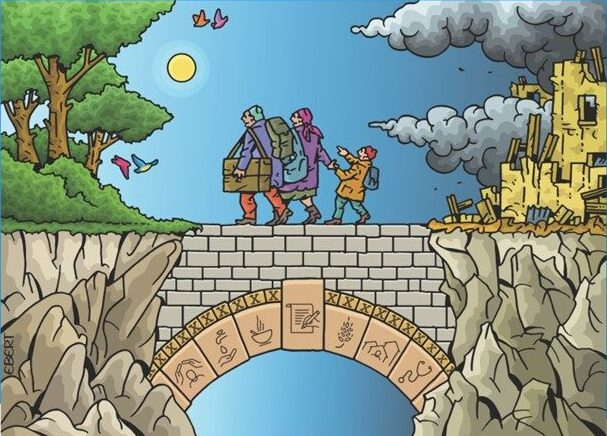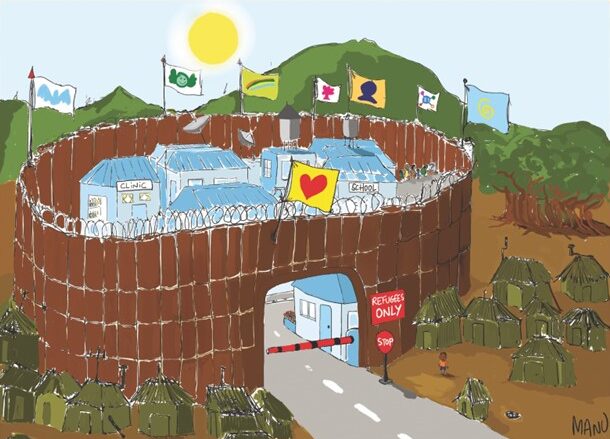Lassonde hosts Humanitarian Response Network of Canada’s Triannual Meeting and Sphere Training
Tags:

In June, York University’s Lassonde School of Engineering hosted a three-day event for the Humanitarian Response Network of Canada’s (HRN) Triannual Meeting and Sphere Training workshop. HRN includes over 35 humanitarian organizations across Canada and aims to strengthen the quality and efficiency of humanitarian action by fostering meaningful conversations around policy issues and standard practices. HRN member-personnel comprise a diverse range of professionals, including humanitarian practitioners, program managers, scientists, researchers and engineers, among others.
“This training initiative sought to equip participants with a comprehensive understanding and practical skills necessary to effectively address emergency situations in alignment with the United Nations Sustainable Development Goals (SDGs),” said Aya Alnaset, Sphere Lead Trainer of the workshop and Technical Director at NSDation Consultancy Services, which facilitated the training workshop.
Representatives from three of York University’s organized research units (ORUs), including Dr. Ali Asgary, Centre International de Formation des Autorités et Leaders (CIFAL), Dr. James Orbinski, Dahdaleh Institute of Global Health Research (DIGHR) and Dr. Jianhong Wu, York Emergency Mitigation, Engagement, Response, and Governance Institute (Y-EMERGE), presented briefly on their expertise and involvement in humanitarian response efforts.
“As engineers and scientists, we know there is a lot we can do to help the humanitarian sector, whether that’s through new programming, partnerships or practical solutions,” said Dr. Jane Goodyer, Dean of Lassonde. “In collaborating with HRN and its member organizations, we are hoping to foster greater understanding and cooperation between engineers and humanitarian response policymakers. We have an excellent opportunity to do so, leveraging York’s ORUs with humanitarian scope.”
In networking with HRN, Lassonde aims to underscore the crucial role that engineering plays in both the immediate response and long-term recovery phases of humanitarian crises, helping to save lives, restore essential services, and build more resilient communities.
“It was a privilege for HRN to have the chance to hold our training within the Lassonde facilities and to have members of the School joining the training,” said Patrice Charpentier, HRN Coordinator, Cooperation Canada. “I believe many of the School’s activities, webinars, presentations and courses could bring a lot to the staff of our members. Because of the urgency to implement in the sector of humanitarian aid, to respond to acute situations populations face, the knowledge and expertise one can acquire in advance of any emergency can have extremely positive impact on the quality of the intervention.”
Dr. Usman Khan, chair of the Department of Civil Engineering at Lassonde, was one of the faculty members who observed the training. “I conduct research with the Dahdaleh Institute for Global Health Research on water, sanitation and hygiene projects, so it’s important for me to understand the Sphere standards and how to apply them to my work. For example, knowing the minimum water quality or volume that should be used for a humanitarian setting is critical. We use this information to guide our models and processes to ensure clean water in humanitarian settings through our safe water optimization tool.”
Engineers play a key role in designing water purification and sanitation systems, reducing the risk of waterborne diseases and improving overall public health in disaster-affected regions. With affected communities, they also co-create and maintain vital infrastructure such as shelters, healthcare facilities, road networks, logistics and supply chain systems, which are essential for ensuring public safety.
Innovative solutions and technologies that facilitate efficient disaster assessment, communication, and resource allocation are all among the solutions engineers jointly create. These can include the co-design and deployment of drones for rapid environmental assessment, communication networks to ensure security and privacy, mobile apps for real-time climate data collection, and mapping systems for effective resource distribution. In addition, they co-develop and maintain renewable energy resources like solar panels and wind turbines, delivering sustainable power to vital infrastructure.
By supporting humanitarian response efforts, Lassonde is looking to advance the UN SDGs through specialized education and training, research and innovation, partnerships and technology transfer, capacity building, data analytics, ethical considerations, and advocacy and awareness.
Dr. Abdel Monem Daymi, Director of Special Programs, Islamic Relief Canada, and co-trainer and facilitator of the workshop, noted that he was, “Privileged to join the training crew to share diverse field experiences from various contexts with participants during the Sphere training, drawing on my background as an Assistant Professor with a PhD in Engineering.”
By embracing a more proactive and multidisciplinary approach, engineering can play an even greater role in humanitarian response, leading to more productive and sustainable solutions for communities in crisis. Dr. Danielle Stodilka, co-trainer and facilitator of the workshop reflected that, “Engineers and scientists can help support pledges made and targets set to increase the effectiveness and quality of humanitarian intervention in various contexts. The welfare of those affected by disaster or conflict are better addressed collaboratively, and by resourcing like-minded communities of practice who seek solutions to better protect the public interest.”

We commit ourselves to attempting consistently to achieve standards and we expect to be held to account accordingly
The Humanitarian Charter, Sphere Handbook

We humanitarian agencies are aware that attempts to provide humanitarian assistance may sometimes have unintended adverse effects. In collaboration with affected communities and authorities, we aim to minimise them
The Humanitarian Charter, Sphere Handbook